Florida Eviction Notice Forms
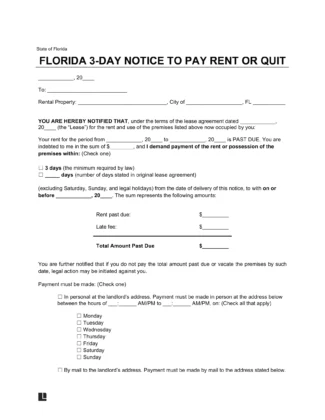
A Florida eviction notice is a document that a landlord uses to informs a tenant they’ve violated the terms of their lease and they’re at risk of being forced out of the property. Depending on the type of violation and terms of the lease, the tenant may be given several days to resolve the problem, such as paying late rent. However, if the tenant does not comply, the landlord can begin eviction.
- By Type
- Eviction Laws & Requirements
- How to Evict a Tenant in Florida
- Related Florida Court Forms
By Type
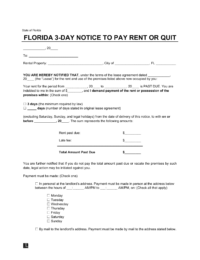
3-Day Eviction Notice (Non-Payment)
Grants a tenant three days to pay rent before proceeding with the eviction process.
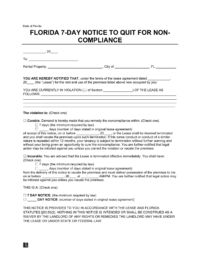
7-Day Eviction Notice (Non-Compliance)
Allows tenants seven days to fix (or “cure”) the problem.
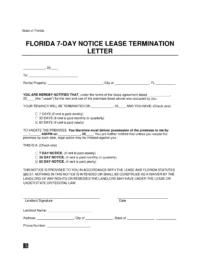
7-Day Notice (Week-to-Week Tenancy)
Formally ends a rental agreement in seven days.
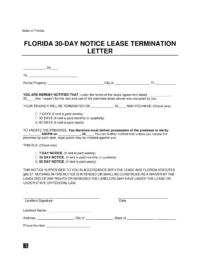
30-Day Notice (Quarter-to-Quarter and Month-to-Month Tenancies)
Allows parties to terminate a month-to-month or quarter-to-quarter tenancy.
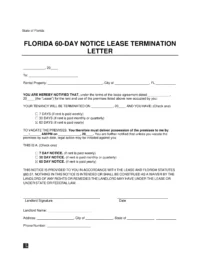
60-Day Notice (Year-to-Year Tenancy)
Ends a yearly rental agreement in compliance with state laws.
Eviction Laws & Requirements
- Eviction Lawsuit: Title VI, Florida Statutes.
- Grace Period for Rent Payment: Specified on the lease.
- Late or Non-Rent Payment Notice: 3 days (83.56(3)).
- Notice of Non-Compliance: 7 days (83.56(2)(a) and 83.56(2)(b)).
- Lease Termination (Month-to-Month): 30 days ( 83.57(3)).
- Response Time After Receiving Complaint: Tenant has five days to respond if the complaint is for eviction only or 20 days if the landlord is seeking damages.
How to Evict a Tenant in Florida
Eviction lawsuits in the state are governed by Chapter 82 and Chapter 83 of the Florida Statutes.
Step 1: Send the Eviction Notice
The landlord gives the eviction notice to the tenant by mail or hand-delivery or simply leaves it in a visible location at the rental unit if the tenant isn’t there.
Step 2: File the Complaint and Summons
The landlord must file the complaint and summons with the court clerk in the county where the rental property is located and pay any associated filing fees.
Step 3: Attend the Court Hearing
The landlord and tenant must appear in court on the assigned date. If the tenant doesn’t respond, the landlord must file a motion for a clerk’s default judgment and a nonmilitary affidavit.
Step 4: File a Motion for Judgment
The landlord then must file a motion for final default judgment and an affidavit of damages, if applicable. At this stage, the landlord should provide the judge with a final default judgment order.
Step 5: Process the Writ of Possession
The landlord must get the court clerk to sign a writ of possession before action can be taken toward evicting the tenant from the premises.
Step 6: Call the Sheriff
Check that the sheriff received the writ of possession. Once they have, you can reclaim the property after a 24-hour window.
Related Florida Court Forms
Documents landlords file with the court:
- Complaint for Eviction: Requests the tenant/s be evicted for failing to pay rent. To be filed after the non-payment eviction notice period has lapsed.
- Complaint for Eviction and Damages: Asks the court to evict tenants for failing to pay rent and to award the landlord damages for past-due rent. Filed after the non-payment eviction notice period has lapsed.
- Complaint for Eviction for Breach of Rental Agreement: Asks the court to evict tenants for reasons other than failing to pay rent. Filed after the non-compliance eviction notice period has lapsed.
Documents landlords must serve the tenant:
- Summons – Eviction Claim: The summons must be served on the tenant and the claim for Eviction. It notifies them that there is a pending court case against them.
- Summons – Damages Claim: The summons must be served on the tenant along with the claim for Damages. It notifies them that there is a pending court case against them.
Documents for landlords to finalize an eviction:
- Motion for Clerk’s Default – Residential Eviction: If the tenant doesn’t respond within five days, the landlord can request that the court award a judgment for eviction in the landlord’s favor.
- Motion for Clerk’s Default – Damages (Residential Eviction): If the tenant doesn’t respond within 20 days, the landlord can request that the court award a judgment for eviction and damages in the landlord’s favor.
- Motion for Default Final Judgment – Residential Eviction: This document is filed with the court after filing the Motion for Clerk’s Default – Residential Eviction and requests a final decision by a court clerk.
- Motion for Default Final Judgment – Damages (Residential Eviction): This document is filed with the court after the Motion for Clerk’s Default – Damages (Residential Eviction) and requests a final decision by a court clerk.
- Final Judgment – Eviction: This document is filed along with the Motion for Default Final Judgment – Residential Eviction and is completed by a judge.
- Final Judgment – Damages: This document is filed along with the Motion for Default Final Judgment – Damages Residential Eviction. The judge completes it and determines the amount of damages.
- Writ of Possession: This form must be provided to the court clerk after the judge has signed the Final Judgment. It’s then sent to the local sheriff’s office to be served on the tenant. The tenant is notified that they have 24 hours to vacate the property or will be forcibly removed.
- Affidavit of Damages: The landlord completes this document to detail the amount of money the tenant owes. It accompanies the Motion for Default Final Judgment.
- Nonmilitary Affidavit: This document states the tenant is not in the military. It accompanies the Motion for Clerk’s Default.
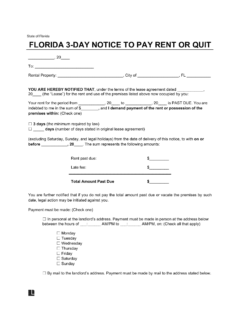
Create Your Florida Eviction Notice in Minutes!








